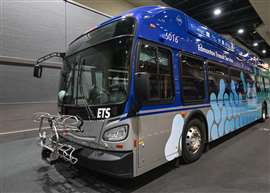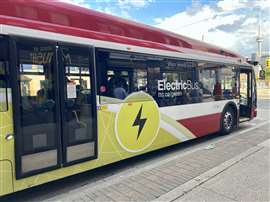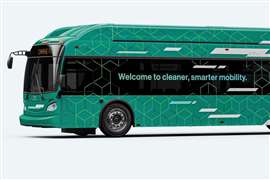CUTRIC conference addressed topics in zero emission transit
05 November 2024
The Canadian Urban Transit Research & Innovation Consortium (CUTRIC) held its sixth annual Zero Emission Transit & Mobility (ZETM) conference in Burlington, Ontario, in late October. CUTRIC promised the event would be a deep dive into a variety of topics, including Canadian transit electrification, zero emission bus rollouts and the use of hydrogen in transit.
Power Progress spoke with several of the ZETM conference organizers at CUTRIC about the conference and its outcomes.
Common Themes
Fatima Al-Setri, communications and events lead for CUTRIC, said some common themes emerged among the presentations at the two-day event. These included discussions about the integration of diverse energy solutions for transit throughout Canada.
 An Edmonton Transit Service bus powered by hydrogen at the 2024 Canadian Hydrogen Convention on April 23, 2024, in Edmonton, Alberta, Canada. (Photo: Artur Widak/NurPhoto)
An Edmonton Transit Service bus powered by hydrogen at the 2024 Canadian Hydrogen Convention on April 23, 2024, in Edmonton, Alberta, Canada. (Photo: Artur Widak/NurPhoto)
“On the one hand, we had a panel that explored the path to transit electrification,” she said. “On the other hand, we discussed hydrogen as a fuel source for transit. But we also talked about RNG and the role that renewable natural gas can play in decarbonizing transit.”
Al-Setri said the discussion made clear there is no one-size-fits-all approach for Canadian transit. Instead, the conversation focused on which power sources worked best in different contexts, such as geographic location, terrain and climate.
“Generally speaking, battery electric (BE) buses worked well in urban centers where you have charging infrastructure that can support charging technologies or shorter routes,” Al-Setri said. “Whereas hydrogen fuel cells offer better range and resilience in colder climates — harsher winter conditions — making them ideal for rural and northern regions.”
Al-Setri added that RNG is generally a more cost-effective alternative for cities that already have established natural gas networks.
“For transit agencies that need a smooth transition from fossil fuels, but due to funding considerations or other considerations, it’s a natural step forward for decarbonizing for them,” she said.
BE Dominance Questioned
The most recent edition of CUTRIC’s zero emission bus (ZEB) database — a new edition will launch on Nov. 6, CUTRIC said — revealed that BE buses make up the clear majority of ZEBs in Canada, followed by compressed natural gas (CNG) buses and fuel cell electric buses a distant third.
 An electric bus operating in Toronto, Ontario, Canada, on July 6, 2024. (Photo: Creative Touch Imaging Ltd./NurPhoto)
An electric bus operating in Toronto, Ontario, Canada, on July 6, 2024. (Photo: Creative Touch Imaging Ltd./NurPhoto)
Jess Smith, manager of commercialization and operations for CUTRIC, remarked on conversations at ZETM that indicate BE buses will in the short term remain the dominant zero emission technology for transit in Canada. However, advances in technologies, including hydrogen fuel cells, could change that.
Using hydrogen fuel cell technology as an example, they said transit agencies are seeing proven applications of the technology.
“Watching more empirical analysis — being able to prove that technology — you’re going to see some more advances in that,” Smith said.
Governmental policies and incentives will also have an impact in the alternative power choices made by Canadian transit agencies.
“If there was suddenly a funding opportunity that supported RNG, we’re going to see a pickup in that technology — same as fuel cell buses, same as battery electric buses,” Smith said.
Finally, they noted that operational constraints over time will drive transit agencies toward particular zero emission technologies.
“We’re looking at our transit agencies to see what really are the important items and the values to that transit agency and how that technology is going to fit pieces of that puzzle,” Smith said. They used BE buses as an example.
“Where a battery electric bus can work really well [is] in an area where they have the ability to put on route chargers randomly throughout the urban area as well as if it is hilly, the climate — there are so many factors that can make a battery electric bus a perfect fit,” Smith said.
However, they added that challenges do exist when implementing BE buses.
“When you see those routes that are more difficult, is it something that, [are you] going to break that route apart and change some of the operational structure of what’s happening within that transit agency or are you going to look at a different technology? Those choices are really going to have an impact.”
Focus on Innovation
Innovations beyond alternative power sources were also discussed at the ZETM conference. One of these is inductive electric vehicle (EV) charging.
“Inductive charging is well on our radar,” Smith said, “and it is on our radar because we have transit agencies reaching out and tapping on our door and saying, about this technology, we’re really seeing it excel in other areas. It could be really great.”
As with alternative power solutions, Smith said that inductive charging lends itself to regions where other technologies face hurdles.
“One of our panelists spoke very openly,” they said. “They live on the East Coast, in an area where they have high winds on a regular basis. So, they definitely live in an area where, if you look at one of those overhead pantograph chargers, that would be bouncing around, and the connection abilities that would be able to have with those rails would have a major impact. Inductive charging might be a little bit more suited.”
Smith added that CUTRIC is no stranger to looking at innovative solutions for transit.
“Innovation is what we love to do. We don’t want to take a technology that has been tried, tested and is at a TRL (technology readiness level) that anybody can buy it, plug it in and it just works. We want to be able to help those transit agencies in the pieces that may cause them a little bit more hesitation.”
CONECTAR-SE COM A EQUIPE






